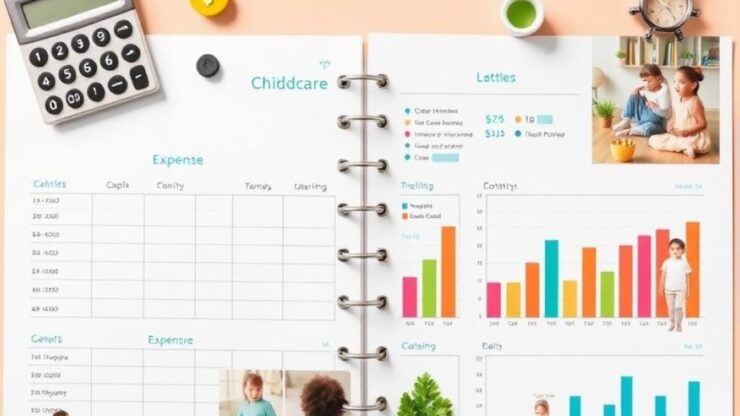Understanding Childcare Options and Costs
As parents navigate the complexities of balancing work and family life, understanding the myriad childcare options available is crucial. Whether you need full-time care, part-time help, or occasional babysitting, each option presents unique benefits and challenges that can significantly affect your budget.
From daycare centers to in-home nannies, the landscape of childcare is diverse, and each choice comes with its own set of costs. Below, we explore the most common childcare options to help you make informed decisions.
- Daycare Centers: These are licensed facilities that offer care for multiple children. Their structured environment is beneficial for socialization but can be costly.
- Family Care Providers: Relatives or friends providing care can be a more affordable option; however, it’s essential to set clear expectations.
- In-Home Nannies: A nanny cares for your child in your home, offering personalized attention at a premium price.
- Preschools: For children aged 3-5, preschools provide early education alongside care, often at a higher cost.
- After-School Programs: These programs cater to school-aged children, providing care and activities post school hours, often at a reasonable rate.
Understanding the financial implications of each childcare option is critical for effective budgeting. Childcare costs can vary widely based on location, age of the child, and type of care. Below is a breakdown of average costs associated with different childcare options.
| Childcare Type | Average Monthly Cost | Notes |
|---|---|---|
| Daycare Centers | $800 – $1,500 | Costs can be higher in urban areas. |
| Family Care Providers | $400 – $1,000 | May vary based on arrangements. |
| In-Home Nannies | $2,000 – $4,000 | Premium service with personalized care. |
| Preschools | $300 – $1,200 | Often includes educational components. |
| After-School Programs | $200 – $600 | Usually more affordable than full-time care. |
Incorporating childcare costs into your budget requires careful planning and consideration. Here are practical strategies to help you manage these expenses effectively:
- Assess Your Options: Evaluate all available childcare options and their respective costs.
- Prioritize Needs vs. Wants: Determine the level of care necessary for your child and avoid unnecessary expenses.
- Utilize Tax Benefits: Investigate tax credits and deductions available for childcare expenses.
- Create a Savings Plan: Set aside funds monthly to cover childcare costs, reducing financial strain.
- Communicate with Care Providers: Open dialogue about costs and expectations can lead to more manageable agreements.
Calculating Your Childcare Budget

Budgeting for childcare is no small feat, especially with the wide array of options available and the varying costs associated with each. To effectively manage these expenses, it is essential to take a structured approach to calculating your childcare budget. By understanding your financial landscape and prioritizing your needs, you can create a budget that accommodates your childcare costs without compromising other financial obligations.
Start by gathering information on all potential childcare options you might consider. This includes daycare centers, family care providers, in-home nannies, preschools, and after-school programs. Each option carries its own pricing structure and associated costs, which can fluctuate based on location and the specific services offered. By creating a comprehensive list of these options, you can begin to evaluate which solutions align best with your family’s requirements and financial constraints.
Before diving into the numbers, take the time to review your overall financial health. Determine your monthly income and identify fixed expenses such as housing, utilities, and groceries. This will help you pinpoint how much disposable income you have available for childcare. Remember, the goal is to integrate childcare costs into your existing budget rather than stretching your finances too thin. Consider also any additional costs associated with childcare, such as transportation or supplies, as these can add up significantly over time.
With a clear understanding of your financial situation, you can now establish a realistic childcare budget. This involves projecting the monthly costs based on the options you’ve researched. For instance, if you decide on a daycare center that charges $1,200 per month, ensure that this aligns with your overall budget after accounting for all other expenses. It is also wise to add a buffer for unexpected costs—childcare can be unpredictable, and having a financial cushion can relieve stress.
To keep track of your childcare expenses effectively, using a budgeting tool or app can simplify the process. Some tools allow you to categorize expenses and set limits, which can be particularly helpful in monitoring ongoing costs. Regularly reviewing and adjusting your budget will ensure that you stay on track, allowing you to adapt to any changes in your childcare needs or financial situation.
| Childcare Option | Estimated Monthly Cost | Notes |
|---|---|---|
| Daycare Centers | $800 – $1,500 | Structured environment, but can be pricey. |
| Family Care Providers | $400 – $1,000 | More affordable, but set clear expectations. |
| In-Home Nannies | $2,000 – $4,000 | Offers personalized care at a premium price. |
| Preschools | $300 – $1,200 | Includes educational components for children aged 3-5. |
| After-School Programs | $200 – $600 | More economical than full-time care for school-aged children. |
Ultimately, the key to successfully incorporating childcare costs into your budget lies in thorough preparation and ongoing management. By being proactive and strategic about your childcare expenses, you can create a financial plan that not only accommodates your child’s needs but also supports your overall financial well-being.
Finding Financial Assistance for Childcare

As the financial demands of raising a child continue to rise, many families are on the lookout for effective ways to alleviate the burden of childcare costs. The good news is that various forms of financial assistance are available to help families manage these expenses. By exploring these options, you can potentially reduce your out-of-pocket costs significantly and ensure that quality childcare remains accessible.
Many governments recognize the challenge of childcare expenses and offer programs designed to assist families. In the United States, for instance, the Child Care and Development Fund (CCDF) provides federal funding to states to help low-income families access childcare. This program can subsidize a portion of your childcare costs, making it easier to afford reliable care. Additionally, some states have their own childcare assistance programs that may offer further support based on need and income level.
Another avenue to explore is the potential for tax benefits related to childcare costs. The Child and Dependent Care Tax Credit allows eligible families to claim a percentage of their childcare expenses on their federal tax returns. This could lead to substantial savings when tax season rolls around. Furthermore, some employers offer Flexible Spending Accounts (FSAs) that allow you to set aside pre-tax dollars for childcare expenses, effectively reducing your taxable income and providing additional savings.
Beyond government programs, various non-profit organizations and community resources can offer financial assistance for childcare. These organizations often provide grants or scholarships aimed at helping families afford quality childcare services, especially for those in underserved communities. Researching local non-profits or community centers can uncover opportunities for support that are tailored to your specific needs.
| Type of Assistance | Description | Eligibility Criteria |
|---|---|---|
| Government Subsidies | Financial aid to help cover childcare costs. | Low-income families, varies by state. |
| Tax Credits | Reductions on tax owed based on childcare expenses. | Dependent on income and childcare costs. |
| Community Programs | Grants or scholarships for childcare support. | Varies by organization and location. |
In conclusion, finding financial assistance for childcare can be instrumental in easing financial pressures associated with parenting. By actively seeking out government resources, exploring tax benefits, and engaging with community organizations, families can create a more manageable budget that prioritizes quality childcare without sacrificing other essential financial obligations.
Incorporating Childcare Costs into Your Overall Budget
As families navigate the complexities of managing finances, integrating childcare expenses into the overall budget becomes a vital consideration. Understanding how to effectively allocate funds for childcare can alleviate financial stress and ensure that families can afford necessary care without compromising other essential expenses. With careful planning, you can create a balanced financial strategy that accommodates your child’s needs while maintaining your household’s financial health.
Before diving into the specifics of childcare costs, it is critical to gain a clear picture of your overall financial situation. Start by listing all sources of income and fixed monthly expenses, including housing, utilities, and groceries. This comprehensive financial overview will serve as the foundation for your budget. By identifying how much disposable income is available after covering essential expenses, you can determine what portion can be allocated specifically to childcare. Remember to factor in additional costs that may arise, such as transportation fees to and from childcare providers or supplies that may be needed for your child’s care.
Once you have assessed your financial landscape, the next step is to evaluate different childcare options in relation to their costs. Each type of childcare, whether it be daycare centers, family care providers, in-home nannies, or after-school programs, comes with its own pricing structures and features. By comparing these options, you can identify which aligns best with your budget constraints and your child’s specific needs. For instance, if a daycare center charges $1,500 monthly and is beyond your means, consider whether a family provider or after-school program might offer a more suitable and affordable alternative.
Furthermore, it’s beneficial to create a detailed table of childcare expenses that outlines each option’s monthly costs, additional fees, and potential savings opportunities through tax credits or employer benefits. This will help clarify the financial impact of each choice and facilitate informed decision-making.
Incorporating childcare costs into your overall budget is not merely about allocating funds; it also involves adopting proactive strategies for managing those costs effectively. One approach is to set a monthly savings goal specifically for childcare expenses. This can be achieved by analyzing your spending habits and identifying areas where you can cut back to redirect those funds into your childcare budget. Additionally, maintaining open communication with your childcare provider about potential changes in care needs or costs can lead to more adaptable agreements that better fit your budget.
Ultimately, the key to successfully incorporating childcare costs into your budget lies in consistent monitoring and adjustment. Regularly revisiting your budget allows you to adapt to any financial changes or unexpected expenses, ensuring that your childcare needs are met without compromising your overall financial wellbeing.
Adjusting Your Budget for Changing Childcare Needs
As your child grows, their childcare needs will inevitably change, prompting you to reevaluate your budget. These transitions can arise from factors such as developmental milestones, shifts in family circumstances, or changes in your work schedule. Recognizing these evolving needs and adapting your financial plan accordingly is essential for maintaining stability in your household budget.
Every phase in a child’s life brings unique requirements and associated costs. For instance, moving from daycare to preschool typically involves a significant adjustment in expenses. Parents must stay alert to when such transitions are likely to occur and anticipate the financial implications of these changes. As your child approaches school age, after-school programs may become necessary, and it is crucial to analyze how these new options fit into your existing financial framework. By forecasting these potential changes, you can proactively adjust your budget to accommodate the upcoming expenses without disrupting your financial health.
Flexibility is key when it comes to managing childcare costs. As your needs change, so should your budget. Creating a dynamic budget that can be easily adjusted allows you to respond to fluctuating childcare demands effectively. This might involve setting aside a dedicated emergency fund for unexpected expenses or reallocating funds from discretionary spending to ensure childcare expenses remain covered. Furthermore, regularly reviewing your budget can help you spot areas where you can save, allowing you to reallocate those savings towards more pressing childcare needs. The more adaptable your budget is, the more prepared you will be for the financial challenges that accompany your child’s growth.
In addition, consider leveraging available resources that can help ease the financial burden during transitions. This might include government assistance programs, tax credits, or community support initiatives. Staying informed about your options can provide you with valuable insights that not only enhance your budgeting efforts but also ensure that quality childcare remains accessible as your circumstances evolve.
Disclaimer
This article has been created or edited with the support of artificial intelligence and is for informational purposes only. The information provided should not be considered investment advice. Please seek the support of a professional advisor before making any investment decisions.






